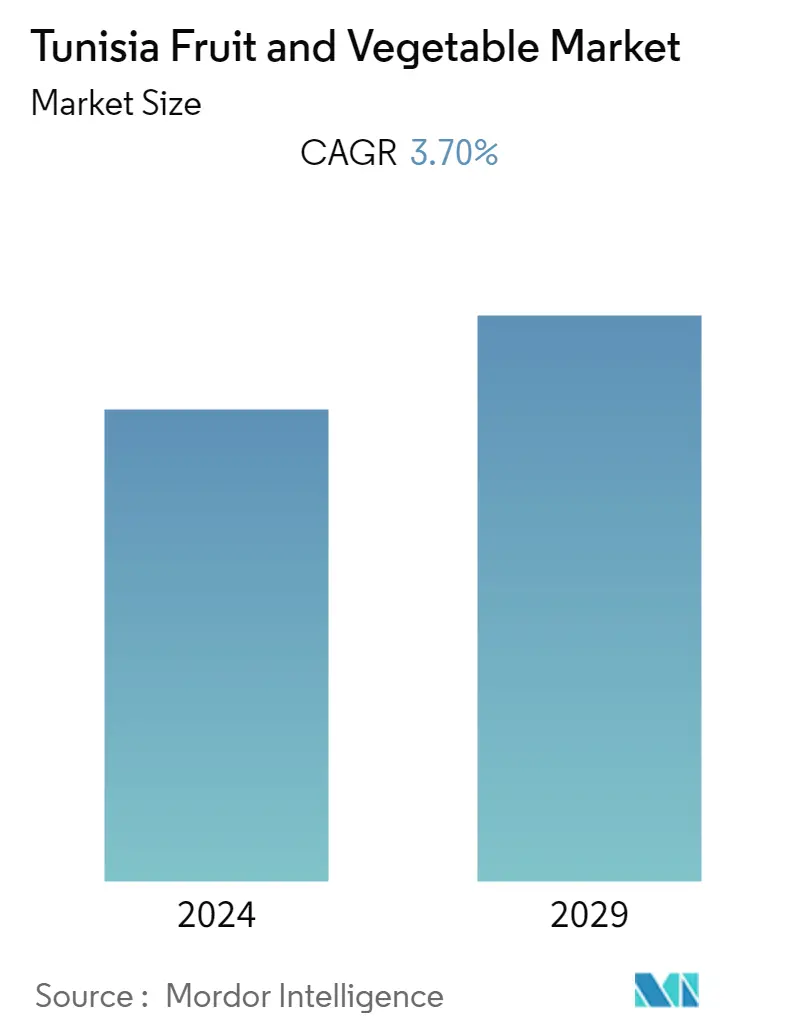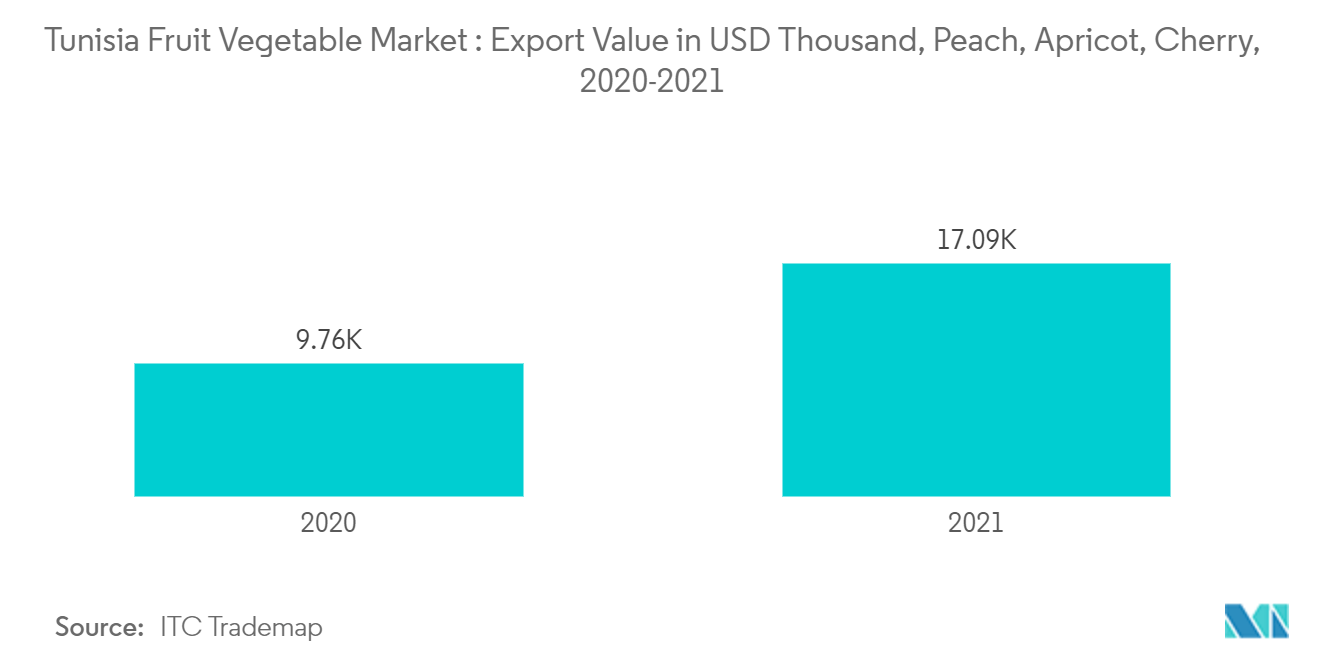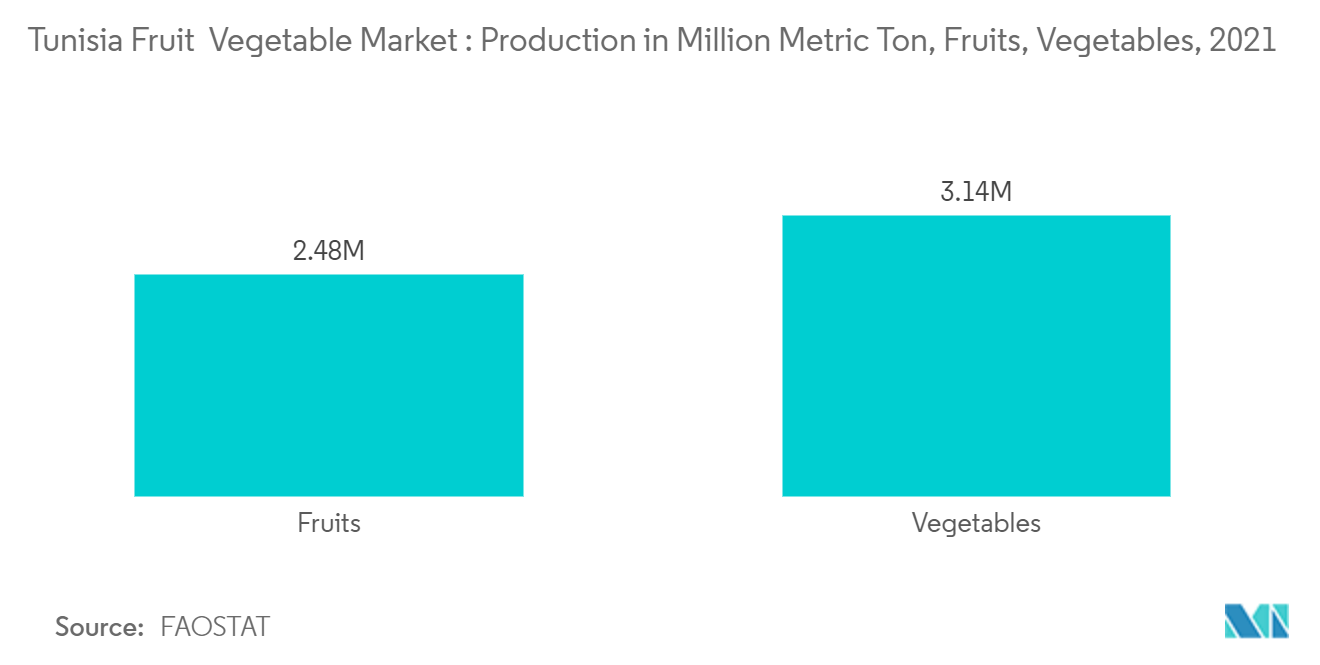Tunisia Fruit and Vegetable Market Size

| Study Period | 2019 - 2029 |
| Base Year For Estimation | 2023 |
| Forecast Data Period | 2024 - 2029 |
| Historical Data Period | 2019 - 2022 |
| CAGR | 3.70 % |
Major Players*Disclaimer: Major Players sorted in no particular order |
Tunisia Fruit and Vegetable Market Analysis
The Tunisian fruit and vegetable market is projected to register a CAGR of 3.7% during the forecast period.
- Increasing consumer demand for affordable fruits such as bananas, oranges, and naartjie, as well as increased demand for derived products such as fruit juices and jams, with rising consumer expenditure on fresh vegetables, have led to the expansion of the fruits and vegetables market in the country.
- The Tunisian fruit and vegetable market is one of the strategic sectors of the country's economy. In 2021, Tunisia produced 3.13 million metric tons of vegetables, 1,41 million metric tons of tomatoes, and 345,000 metric tons of dates. Tunisian agriculture will contribute to 9.1% of the GDP in 2021. Olives, dates, and fresh fruits are grown for international and domestic consumption. Agricultural produce contributes to 6.0% of the total export earnings in the region.
- Furthermore, Tunisia is the second-largest exporter of organic products, with an area of 297,137 hectares in 2021. Its share of total agricultural land is 3.0%, mainly olive, date, vegetable, aromatic, medicinal plants, and vines. About 80.0% of the Tunisian organic produce is exported, and it is the only African country that has the recognition of equivalence with the EU and Switzerland pertaining to organic agriculture.
Tunisia Fruit and Vegetable Market Trends
Rise in Export of Fruits and Vegetables
- The exceptionally dry climate of Tunisia contributes to a very low incidence of aflatoxin in dried fruits, making the country one of the major exporters of dried fruits in that region. The geography and the proximity to large international markets, like the European, Middle Eastern, and North African (MENA) regions, have made Tunisia the gateway for other African countries. Minimum support prices, market liberalization, enhanced rural transport infrastructure, and incentives for investment are also driving Tunisia's fruit and vegetable market.
- According to the data, pomegranates and watermelons were Tunisia's most exported fruits in 2021, with volumes exceeding 12,000 metric tons, followed by peaches with 9,200 metric tons. Morocco, Libya, France, Italy, Germany, and Spain are some of the major importers of Tunisian fruits, whereas Italy, France, the Netherlands, and Germany are the major importers of Tunisian vegetables.
- High-knowledge-intensive services, such as information and communications technology, business services, and digital financial services, are among the primary reasons restraining export diversification in the country. Leveraging high-knowledge-intensive services to improve productivity and competitiveness will be essential to the country's value-added diversification and growth.

Vegetable Production Dominates the Market
- Tunisia leads in the production of vegetables compared to fruits, which accounted for 3.13 million metric tons in 2021. This was an 8.6% increase compared to the production volume in 2018. Fruit production volume reached 2.47 million metric tons in 2021.
- Tomatoes, onion, chili, pepper, carrots, pumpkins, and cucumber are some of the vegetables grown majorly in the region, among which tomatoes and potatoes are the important comestibles of Tunisians. Non-profit organizations and various regional regulatory authorities promoting vegetable breeding an increase in food consumption, and the need for sustainable agriculture development are some of the aspects driving market expansion.
- The cultivation of processing tomatoes occupies a strategic position in the agricultural development policy of the country. According to the Ministry of agriculture, the sector mobilizes more than 10,000 farmers, with a total area that exceeded 16,000 hectares in 2021, for an estimated production of 1.42 million metric tons.
- The rising consumption of fresh tomatoes, as these products are easy, fast sources of energy and nutrition for consumers, is one of the segment's primary driving forces. Thus, the production of vegetables in the region has been significantly increasing in recent years, showing production growth.

Tunisia Fruit and Vegetable Market News
- April 2022: Tunisian exports of fruits and vegetables to Libya have gone up through the Ras Ajdair border post, with a 23% year-on-year increase in July. Tunisian exports to Libya reached 3,727 tons. According to the Observatory for Tunisian Farmers, the increase is due to the export of watermelons to Libya by 212%, which is 2,370 tons.
Tunisia Fruit and Vegetable Market Report - Table of Contents
1. INTRODUCTION
- 1.1 Study Assumptions and Market Definition
- 1.2 Scope of the Study
2. RESEARCH METHODOLOGY
3. EXECUTIVE SUMMARY
4. MARKET DYNAMICS
- 4.1 Market Overview
- 4.2 Market Drivers
- 4.3 Market Restraints
5. MARKET SEGMENTATION
-
5.1 Type (Production Analysis by Volume, Consumption Analysis by Volume and Value, Import Analysis by Volume and Value, Export Analysis by Volume and Value, and Price Trend Analysis)
- 5.1.1 Vegetables
- 5.1.2 Fruits
6. INTERNATIONAL TRADE AND PRICE ANALYSIS
- 6.1 Grapes
- 6.2 Oranges
- 6.3 Apples
- 6.4 Pears
- 6.5 Bananas
- 6.6 Peaches
- 6.7 Lemons and Limes
- 6.8 Potatoes
- 6.9 Tomatoes
- 6.10 Pumpkin, Squashes, and Gourds
- 6.11 Carrot and Turnips
- 6.12 Cucumber and Gherkins
- 6.13 Lettuce and Chicory
- 6.14 Cabbage and Other Brassicas
- 6.15 Maize Green
- 6.16 Sweet Potatoes
- 6.17 Cow Peas
7. REGIONAL ANALYSIS
- 7.1 PESTLE ANALYSIS
- 7.2 Value Chain/Supply Chain Analysis
- 7.3 Government Policies
8. COMPETITIVE LANDSCAPE
- 8.1 Distribution Network and Retail Analysis
- 8.2 Profile of Key Players
9. MARKET OPPORTUNITIES AND FUTURE TRENDS
** Subject To AvailablityTunisia Fruit and Vegetable Industry Segmentation
The changing agro-climatic factors of the Mediterranean region have favored the development of different fruit trees and nuts in Tunisia. The country also produces fruit crops, such as citrus, grape, pomegranate, apple, and peach, and among vegetables, it produces potato, tomato, pepper, onion, and artichoke.
The Tunisian fruit and vegetable market is segmented by type (fruit and vegetables). The report includes production analysis (volume), consumption analysis (value and volume), export analysis (value and volume), import analysis (value and volume), and price trend analysis.
The report offers market size and forecast in terms of value in USD million and volume in metric tons for the above-mentioned segments.
| Type (Production Analysis by Volume, Consumption Analysis by Volume and Value, Import Analysis by Volume and Value, Export Analysis by Volume and Value, and Price Trend Analysis) | Vegetables |
| Fruits |
Tunisia Fruit and Vegetable Market Research FAQs
What is the current Tunisia Fruit and Vegetable Market size?
The Tunisia Fruit and Vegetable Market is projected to register a CAGR of 3.70% during the forecast period (2024-2029)
What years does this Tunisia Fruit and Vegetable Market cover?
The report covers the Tunisia Fruit and Vegetable Market historical market size for years: 2019, 2020, 2021, 2022 and 2023. The report also forecasts the Tunisia Fruit and Vegetable Market size for years: 2024, 2025, 2026, 2027, 2028 and 2029.
Fruit and Vegetable in Tunisia Industry Report
Statistics for the 2024 Fruit and Vegetable in Tunisia market share, size and revenue growth rate, created by Mordor Intelligence™ Industry Reports. Fruit and Vegetable in Tunisia analysis includes a market forecast outlook to 2029 and historical overview. Get a sample of this industry analysis as a free report PDF download.



